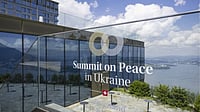And clearly, Peter Hopkirk, the much-acclaimed author of The Great Game, too is much fascinated by Kipling's masterpiece. In his latest book, he idolises the creator of characters like Kim, the old and lovable Tibetan lama, Lurgan Sahib, Mahbub Ali, Colonel Creighton and others; he is mesmerised by the intelligence ploy used by the British known as the Great Game; and his personal adventures make him uniquely qualified to write a book attempting to rediscover the world of Kipling that has slowly slipped into history.
In other words, Hopkirk tells the story behind a story. Tough business, to say the least, especially since the author's qualifi-cations can easily turn disadvantageous. Knowing the Great Game inside out makes the scope for romanticising the improbable highly possible. Yet, what makes the book distinctive is Hopkirk's ability to look into the facts of contemporary times and place them in the context of Kipling with mature circumspection.
Time and again, Hopkirk talks of Kipling with overt admiration. There are occasions when he dismisses hostile criticism, like those relating to Kipling's "smartness and superficiality, jingoism and aggressiveness, rococo fictional types and overloaded pseudo prose". But his analysis follows a scientific method. Hopkirk isn't out to defend him just because he happened to immortalise the Great Game. If he can dismiss Kipling's antagonistic critics, it is primarily since he wants to pay a tribute to his immortalised greatness. Of course, the attitude of the author is encouraged by an assurance that Kipling fans do not view him as a reactionary imperialist. Like Hopkirk, though less passionately in most cases, they are devoted to his brilliance. And importantly, Kipling fans easily outnumber his antagonists, one of the reasons why his books continue to disappear from the racks even today.
Another aspect—here, one wonders why Hopkirk calls his work a "pedestrian effort"—that makes the entire exercise noteworthy is the same scientific approach characterising the voyage of discovery. He quotes from the original book and compresses several sub-plots to highlight the thin line of demarcation between Kipling's fictional 'imaginary' and the existing 'real'; he travels wherever Kim's footsteps took him during the course of his participation in the Great Game.
The author's erudition tends to leave the reader in awe. He scrutinises circumstantial details as they exist today. And, his approach shows that he refuses to accept anything at face value. For instance, a museum commonly viewed as Kipling's source of inspiration for the 'Ajaib Ghar' is shown as existing in a different location: "No longer a museum of Buddhist art treasures, it has been turned into a covered market, selling a host of everyday goods."
Throughout the book, Peter Hopkirk raises relevant queries that have obsessed Kipling scholars for a long time. He wonders who is the book's hero: Kim or the old Tibetan lama. Here, Kim is similar to Thomas Hardy's Mayor of Casterbridge, about which opinions are divided whether the hero is the penitent original mayor Michael Henchard or Donald Farfrae, his progressive successor. In the case of this Kipling novel, several readers vote for the lama, just as many Hardy readers find Farfrae the real hero. Hopkirk's choice is obvious, though understated. Though he traces the roots of Kim as well as the lama—not to forget Lurgan Sahib and many others—it is clear that Hopkirk's personal hero is the Great Game itself.


























